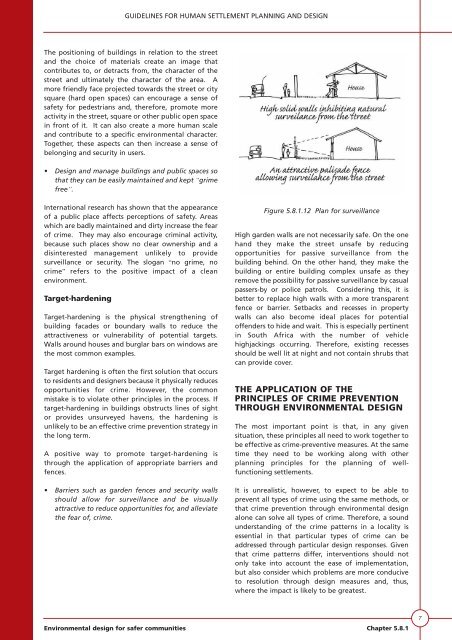VOLUME 1 HUMAN SETTLEMENT PLANNING AND ... - CSIR
VOLUME 1 HUMAN SETTLEMENT PLANNING AND ... - CSIR
VOLUME 1 HUMAN SETTLEMENT PLANNING AND ... - CSIR
- No tags were found...
You also want an ePaper? Increase the reach of your titles
YUMPU automatically turns print PDFs into web optimized ePapers that Google loves.
GUIDELINES FOR <strong>HUMAN</strong> <strong>SETTLEMENT</strong> <strong>PLANNING</strong> <strong>AND</strong> DESIGNThe positioning of buildings in relation to the streetand the choice of materials create an image thatcontributes to, or detracts from, the character of thestreet and ultimately the character of the area. Amore friendly face projected towards the street or citysquare (hard open spaces) can encourage a sense ofsafety for pedestrians and, therefore, promote moreactivity in the street, square or other public open spacein front of it. It can also create a more human scaleand contribute to a specific environmental character.Together, these aspects can then increase a sense ofbelonging and security in users.• Design and manage buildings and public spaces sothat they can be easily maintained and kept “grimefree”.International research has shown that the appearanceof a public place affects perceptions of safety. Areaswhich are badly maintained and dirty increase the fearof crime. They may also encourage criminal activity,because such places show no clear ownership and adisinterested management unlikely to providesurveillance or security. The slogan “no grime, nocrime” refers to the positive impact of a cleanenvironment.Target-hardeningTarget-hardening is the physical strengthening ofbuilding facades or boundary walls to reduce theattractiveness or vulnerability of potential targets.Walls around houses and burglar bars on windows arethe most common examples.Target hardening is often the first solution that occursto residents and designers because it physically reducesopportunities for crime. However, the commonmistake is to violate other principles in the process. Iftarget-hardening in buildings obstructs lines of sightor provides unsurveyed havens, the hardening isunlikely to be an effective crime prevention strategy inthe long term.A positive way to promote target-hardening isthrough the application of appropriate barriers andfences.• Barriers such as garden fences and security wallsshould allow for surveillance and be visuallyattractive to reduce opportunities for, and alleviatethe fear of, crime.Figure 5.8.1.12 Plan for surveillanceHigh garden walls are not necessarily safe. On the onehand they make the street unsafe by reducingopportunities for passive surveillance from thebuilding behind. On the other hand, they make thebuilding or entire building complex unsafe as theyremove the possibility for passive surveillance by casualpassers-by or police patrols. Considering this, it isbetter to replace high walls with a more transparentfence or barrier. Setbacks and recesses in propertywalls can also become ideal places for potentialoffenders to hide and wait. This is especially pertinentin South Africa with the number of vehiclehighjackings occurring. Therefore, existing recessesshould be well lit at night and not contain shrubs thatcan provide cover.THE APPLICATION OF THEPRINCIPLES OF CRIME PREVENTIONTHROUGH ENVIRONMENTAL DESIGNThe most important point is that, in any givensituation, these principles all need to work together tobe effective as crime-preventive measures. At the sametime they need to be working along with otherplanning principles for the planning of wellfunctioningsettlements.It is unrealistic, however, to expect to be able toprevent all types of crime using the same methods, orthat crime prevention through environmental designalone can solve all types of crime. Therefore, a soundunderstanding of the crime patterns in a locality isessential in that particular types of crime can beaddressed through particular design responses. Giventhat crime patterns differ, interventions should notonly take into account the ease of implementation,but also consider which problems are more conduciveto resolution through design measures and, thus,where the impact is likely to be greatest.Environmental design for safer communities Chapter 5.8.17
















